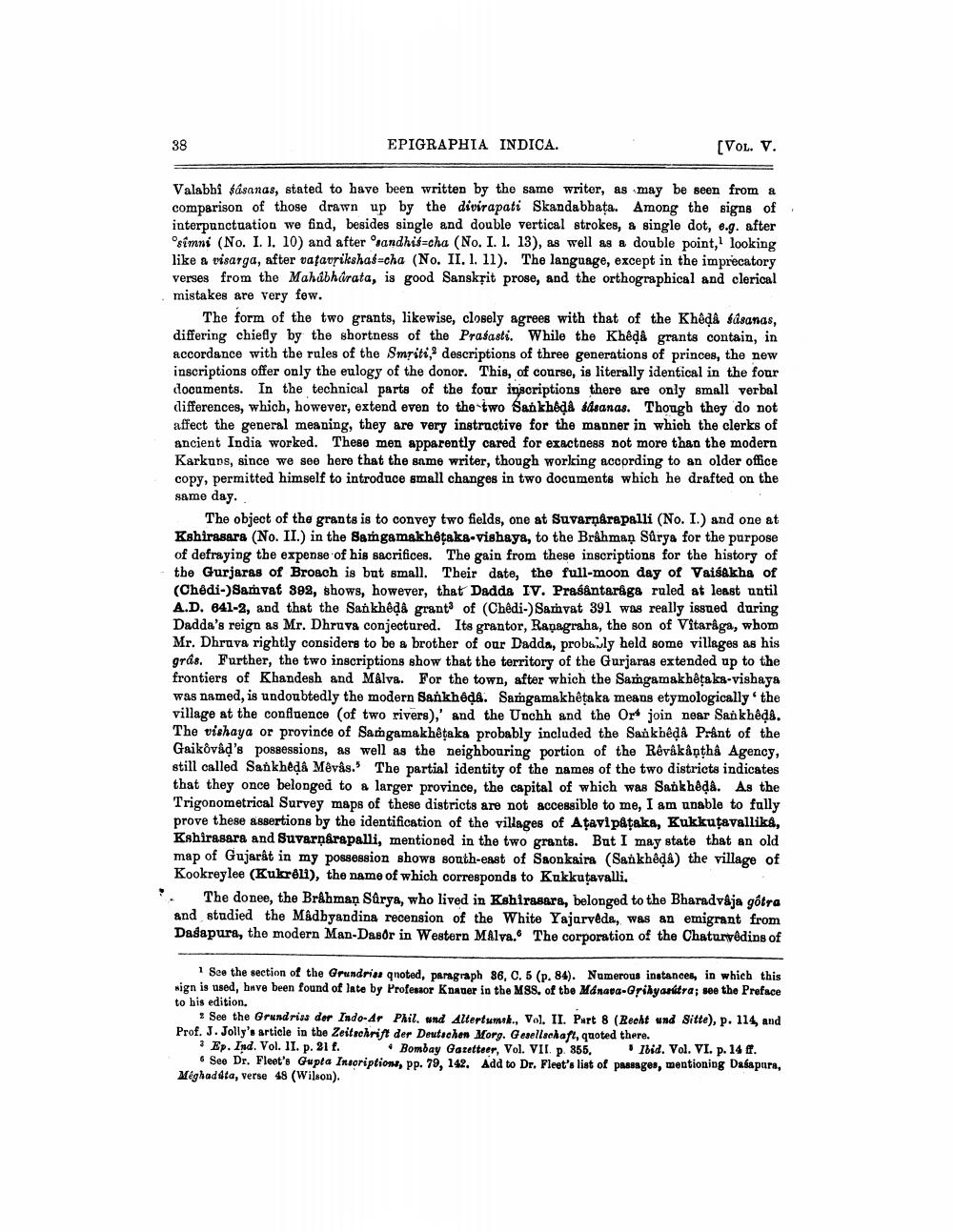________________
38
EPIGRAPHIA INDICA.
[Vol. V.
Valabhi sasanas, stated to have been written by the same writer, as may be seen from a comparison of those drawn up by the divirapati Skandabhata. Among the signs of interpunctuation we find, besides single and double vertical strokes, a single dot, e.g. after Osimni (No. I. 1. 10) and after 'sandhis-cha (No. I. 1. 13), as well as a double point, looking like a visarga, after vafavrikshas-cha (No. II. 1. 11). The language, except in the imprecatory
verses from the Mahabharata, is good Sanskțit prose, and the orthographical and clerical . mistakes are very few.
The form of the two grants, likewise, closely agrees with that of the Khêdå sdsanas, differing chiefly by the shortness of the Prasasti. While the Kheda grants contain, in accordance with the rules of the Smriti, descriptions of three generations of princes, the new inscriptions offer only the eulogy of the donor. This, of course, is literally identical in the four documents. In the technical parts of the four inscriptions there are only small verbal differences, which, however, extend even to the two Sankheda ddsanas. Though they do not affect the general meaning, they are very instructive for the manner in which the clerks of ancient India worked. These men apparently cared for exactness not more than the modern Karkurs, since we see here that the same writer, though working according to an older office copy, permitted himself to introduce small changes in two documents which he drafted on the same day.
The object of the grants is to convey two fields, one at Suvarnarapalli (No. I.) and one at Kshirasara (No. II.) in the Samgamakhêtaka vishaya, to the Brahman Sürya for the purpose of defraying the expense of his sacrifices. The gain from these inscriptions for the history of the Gurjaras of Broach is but small. Their date, the full-moon day of Vaisakha of (Chedi-) Samvat 892, shows, however, that Dadda IV. Prasantaraga ruled at least until A.D. 641-2, and that the Sankheda grants of (Chêdi-) Samvat 391 was really issued during Dadda's reign as Mr. Dhruva conjectured. Its grantor, Ranagraha, the son of Vitaråga, whom Mr. Dhruva rightly considers to be a brother of our Dadda, probavly held some villages as his grâs. Further, the two inscriptions show that the territory of the Gurjaras extended up to the frontiers of Khandesh and Mälva. For the town, after which the Samgamakhêtaka-vishaya was named, is undoubtedly the modern Sankhed&. Samgamakhêtaka means etymologically the village at the confluence (of two rivers), and the Unchh and the Or* join near Sankhede. The vishaya or province of Samgamakhêtaka probably included the Sankheda Print of the Gaikôvad's possessions, as well as the neighbouring portion of the Rêvåkåņķhà Agency, still called Sankheda Mêvas. The partial identity of the names of the two districts indicates that they once belonged to a larger province, the capital of which was Sankhôda. As the Trigonometrical Survey maps of these districts are not accessible to me, I am unable to fully prove these assertions by the identification of the villages of Atavi påtaka, Kukkuțavallika, Kshirasara and Suvarnirapalli, mentioned in the two grants. But I may state that an old map of Gujarat in my possession shows south-east of Saonkaira (Sankhôda) the village of Kookreylee (Kukrell), the name of which corresponds to Kukkutavalli.
The donee, the Brahman Sürya, who lived in Kshirasara, belonged to the Bharadvája gôtra and studied the M&dbyanding recension of the White Yajarvéda, was an emigrant from Dagapura, the modern Man-Dasor in Western Malva. The corporation of the Chaturvedins of
1 See the section of the Grundria qnoted, paragraph 86, C. 5 (p. 84). Numerous instances, in which this wign is used, have been found of late by Professor Knager in the MSS. of the Manara-Grikyanitra; see the Preface to his edition.
See the Grundriss der Indo-Ar Phil. und Altertumsk., Vol. II. Part 8 (Recht und Sitte), p. 114, and Prof. J. Jolly's article in the Zeitschrift der Deutschen Morg. Gesellschaft, quoted there. * Ep. Ind. Vol. II. p. 21 f.
Bombay Gazetteer, Vol. VII p. 855, lbid. Vol. VI. p. 14 . • Seo Dr. Fleet's Gupta Inscription, pp. 79, 142. Add to Dr. Fleet's list of passages, mentioning Dasapura, Méghaddta, verse 48 (Wilson).




